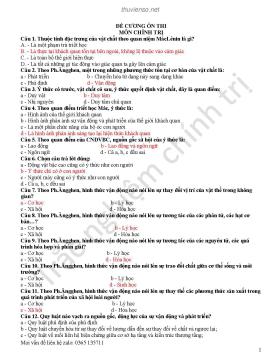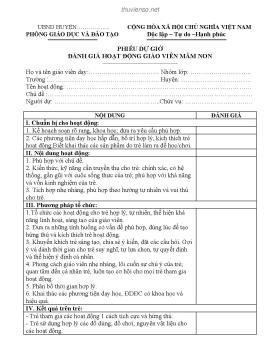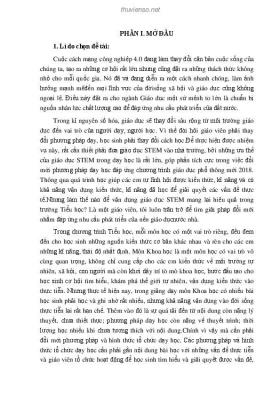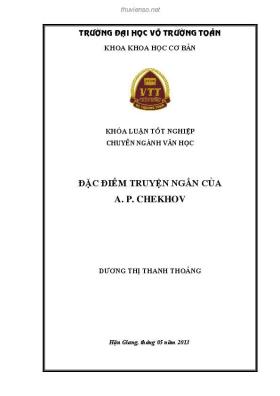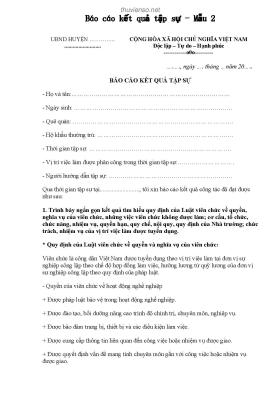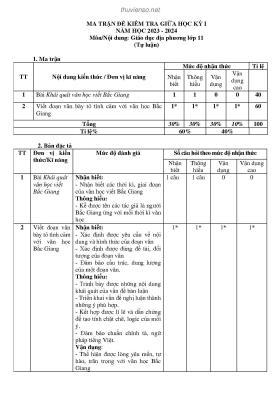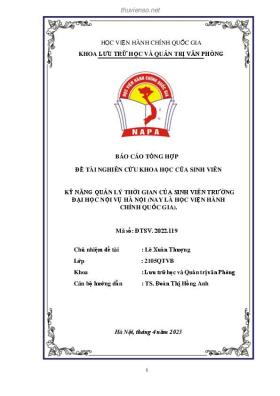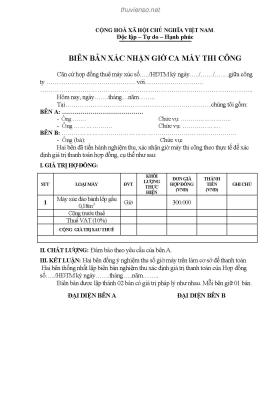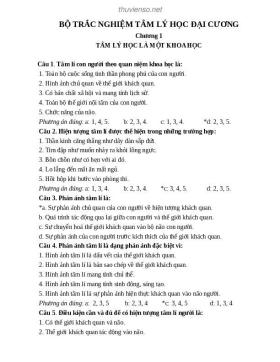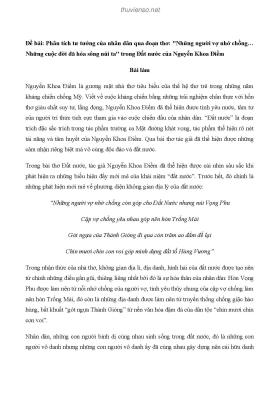
Lecture Human anatomy and physiology - Chapter 3: Cells (part d)
Số trang: 9
Loại file: ppt
Dung lượng: 539.50 KB
Lượt xem: 11
Lượt tải: 0
Xem trước 2 trang đầu tiên của tài liệu này:
Thông tin tài liệu:
This chapter provides knowledge of cell cycle. The main contents of this chapter include all of the following: List the phases of the cell cycle and describe the key events of each phase, describe the process of DNA replication.
Nội dung trích xuất từ tài liệu:
Lecture Human anatomy and physiology - Chapter 3: Cells (part d) PowerPoint® Lecture Slides prepared by Janice Meeking, Mount Royal College CHAPTER 3 Cells: The Living Units: Part DCopyright © 2010 Pearson Education, Inc. Cell Cycle • Defines changes from formation of the cell until it reproduces • Includes: • Interphase • Cell division (mitotic phase)Copyright © 2010 Pearson Education, Inc. Interphase • Period from cell formation to cell division • Nuclear material called chromatin • Four subphases: • G1 (gap 1)—vigorous growth and metabolism • G0—gap phase in cells that permanently cease dividing • S (synthetic)—DNA replication • G2 (gap 2)—preparation for divisionCopyright © 2010 Pearson Education, Inc. G1 checkpoint (restriction point) S Growth and DNA synthesis G2 Growth and final G1 preparations for Growth M division G2 checkpointCopyright © 2010 Pearson Education, Inc. Figure 3.31 Centrosomes Interphase (each has 2 Plasma centrioles) membrane Nucleolus Chromatin Nuclear Interphase envelopeCopyright © 2010 Pearson Education, Inc. Figure 3.33 DNA Replication • DNA helices begin unwinding from the nucleosomes • Helicase untwists the double helix and exposes complementary chains • The Y-shaped site of replication is the replication fork • Each nucleotide strand serves as a template for building a new complementary strandCopyright © 2010 Pearson Education, Inc. DNA Replication • DNA polymerase only works in one direction • Continuous leading strand is synthesized • Discontinuous lagging strand is synthesized in segments • DNA ligase splices together short segments of discontinuous strandCopyright © 2010 Pearson Education, Inc. DNA Replication • End result: two DNA molecules formed from the original • This process is called semiconservative replicationCopyright © 2010 Pearson Education, Inc. Old strand acts as a DNA polymerase template for synthesis Free nucleotides Chromosome of new strand Leading strand Two new strands (leading and lagging) synthesized in opposite directions Old DNA Lagging Helicase unwinds strand the double helix and exposes the bases Replication Adenine fork Thymine Cytosine Guanine DNA polymerase Old (template) strandCopyright © 2010 Pearson Education, Inc. Figure 3.32
Nội dung trích xuất từ tài liệu:
Lecture Human anatomy and physiology - Chapter 3: Cells (part d) PowerPoint® Lecture Slides prepared by Janice Meeking, Mount Royal College CHAPTER 3 Cells: The Living Units: Part DCopyright © 2010 Pearson Education, Inc. Cell Cycle • Defines changes from formation of the cell until it reproduces • Includes: • Interphase • Cell division (mitotic phase)Copyright © 2010 Pearson Education, Inc. Interphase • Period from cell formation to cell division • Nuclear material called chromatin • Four subphases: • G1 (gap 1)—vigorous growth and metabolism • G0—gap phase in cells that permanently cease dividing • S (synthetic)—DNA replication • G2 (gap 2)—preparation for divisionCopyright © 2010 Pearson Education, Inc. G1 checkpoint (restriction point) S Growth and DNA synthesis G2 Growth and final G1 preparations for Growth M division G2 checkpointCopyright © 2010 Pearson Education, Inc. Figure 3.31 Centrosomes Interphase (each has 2 Plasma centrioles) membrane Nucleolus Chromatin Nuclear Interphase envelopeCopyright © 2010 Pearson Education, Inc. Figure 3.33 DNA Replication • DNA helices begin unwinding from the nucleosomes • Helicase untwists the double helix and exposes complementary chains • The Y-shaped site of replication is the replication fork • Each nucleotide strand serves as a template for building a new complementary strandCopyright © 2010 Pearson Education, Inc. DNA Replication • DNA polymerase only works in one direction • Continuous leading strand is synthesized • Discontinuous lagging strand is synthesized in segments • DNA ligase splices together short segments of discontinuous strandCopyright © 2010 Pearson Education, Inc. DNA Replication • End result: two DNA molecules formed from the original • This process is called semiconservative replicationCopyright © 2010 Pearson Education, Inc. Old strand acts as a DNA polymerase template for synthesis Free nucleotides Chromosome of new strand Leading strand Two new strands (leading and lagging) synthesized in opposite directions Old DNA Lagging Helicase unwinds strand the double helix and exposes the bases Replication Adenine fork Thymine Cytosine Guanine DNA polymerase Old (template) strandCopyright © 2010 Pearson Education, Inc. Figure 3.32
Tìm kiếm theo từ khóa liên quan:
Lecture Biology Human anatomy Human physiology The human body The organ systems of humans Cell cycleGợi ý tài liệu liên quan:
-
Ebook Cardio-respiratory control in vertebrates - Comparative and evolutionary aspects: Part 2
297 trang 30 0 0 -
Ebook The cell - A molecular approach (4/E): Part 3
352 trang 23 0 0 -
Lecture Biology (6e): Chapter 11 - Campbell, Reece
59 trang 16 0 0 -
Lecture Human anatomy and physiology - Chapter 15: The special senses (part a)
39 trang 11 0 0 -
Simulated microgravity altered the cell cycle progression of porcine granulosa cells
7 trang 11 0 0 -
Lecture Human anatomy and physiology - Chapter 3: Cells (part a)
36 trang 11 0 0 -
12 trang 11 0 0
-
Lecture Human anatomy and physiology - Chapter 3: Cells (part b)
37 trang 10 0 0 -
Lecture Human anatomy and physiology - Chapter 10: The muscular system (part c)
45 trang 10 0 0 -
Lecture Biology: Concepts and connections (Sixth edition) – Chapter 11
89 trang 10 0 0



